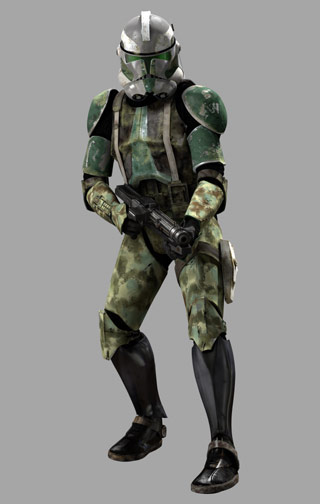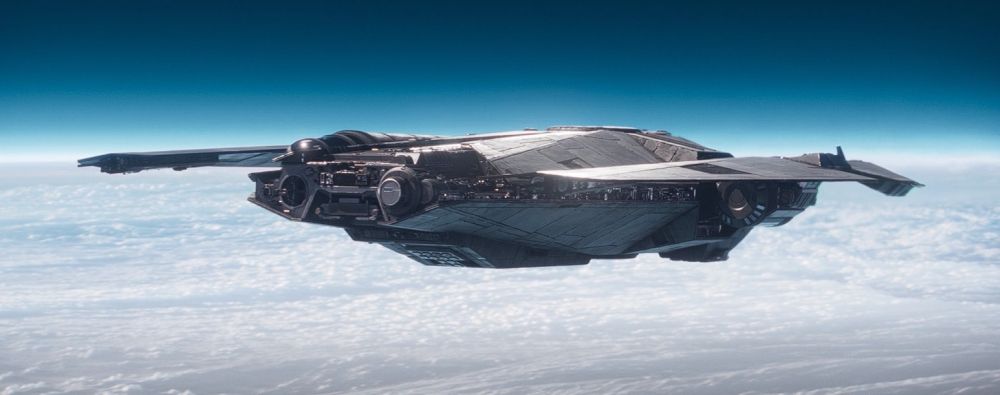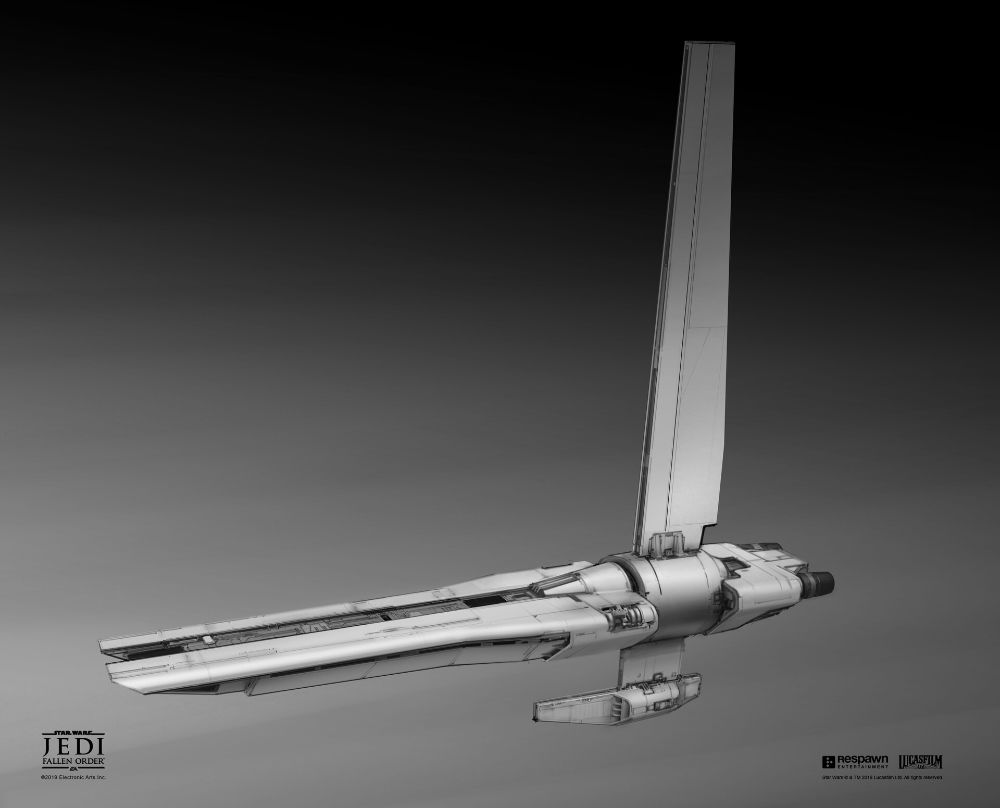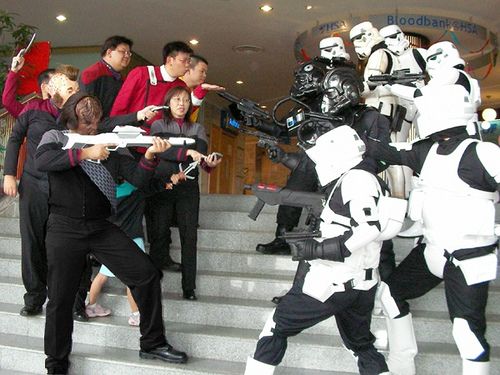Rev.
01: Sunday, April 11, 2010
Rev.
02: Wednesday, March 02, 2011
1.
Funny pic stolen from here: http://www.flickr.com/photos/inju/2738867068/
2.
Reformatted overall layout to be better suited to a plain text format.
3.
Separated principal categories by a line of asterisks and changed each
beginning category name to all caps.
4.
Categories which have been revised have been noted with an asterisk in front of
the category name.
5.
Per comments have expanded and further detailed the Food and Gunpowder
sections.
**************************************************
*OVERVIEW
Star
Trek tech has the essential appearance of being more ?energy? based.
That
is using more esoteric physics and molecular manipulation to generate many of
their technologies and effects.
Star
Wars tech appears to be more ?mechanical? in nature, think steampunk,
cyberpunk, a ?57 Chevy, etc.
Thus
while the Star Trek universe appears crisp and clean, the Star Wars is flying
along as fast as its steampunk supercharged hyperdrives and droids can shake
it!
**************************************************
*WARP
SPEED vs. HYPERDRIVE
Warp
Drive Scale = ST:TNG (Enterprise D, Captain Picard)
Warp
Drive 01 = Hyperdrive x100
Warp
Drive 02 = Hyperdrive x90
Warp
Drive 03 = Hyperdrive x80
Warp
Drive 04 = Hyperdrive x70
Warp
Drive 05 = Hyperdrive x60
Warp
Drive 06 = Hyperdrive x50
Warp
Drive 07 = Hyperdrive x40
Warp
Drive 08 = Hyperdrive x30
Warp
Drive 09 = Hyperdrive x20
Warp
Drive 10 = Hyperdrive x10
Warp
Drive 11 = Hyperdrive x09
Warp
Drive 12 = Hyperdrive x08
Warp
Drive 13 = Hyperdrive x07
Warp
Drive 14 = Hyperdrive x06
Warp
Drive 15 = Hyperdrive x05
Warp
Drive 16 = Hyperdrive x04
Warp
Drive 17 = Hyperdrive x03
Warp
Drive 18 = Hyperdrive x02
Warp
Drive 19 = Hyperdrive x01
Warp
Drive 19.5 = Hyperdrive x00.5
Other Star Trek Propulsion
Technologies:
Transwarp Drive: Borg, Federation, and Voth
Quantum
Slipstream Drive:
Federation
While
the Federation has not yet been able to completely crack the secrets of Transwarp or Quantum drives, they have made progress
towards these technologies (just check the interwebs:
http://memory-alpha.org/en/wiki/Portal:Main).
They
will likely have some experimental prototypes of these drives in use. Play it
by ear as to what you think they should be rated at.
From
the information described in various sources on-line and what I recall
regarding the Quantum drive I would think it would be just about comparable to
the hyperdive?maybe it?s a primitive version of the hyperdrive?
This
could be a good in, for introducing a whole shipload of Trekkers to the Star
Wars universe!
SUBLIGHT (Space &
Maneuverability):
Scale:
Capital
--Space:
+2D, Star Trek speeds for capital ships are faster.
--Maneuverability:
+2D, Star Trek maneuverability for capital ships is better.
--Note;
this is due not necessarily to the power of Star Trek sublight engines, but to
the design and construction of the vessels (see Hull for additional information).
Scale:
Starfighter, Light Freighter
--Space:
Equivalent
--Maneuverability:
Equivalent
Picard Maneuver:
The
Star Trek Warp Drive
allows for this maneuver, whereas a hyperdrive requires a more complete amount
of information to engage its drive system, even when performing a microjump.
Thus
a Warp Drive
can be utilized for this type of maneuver, while a hyperdrive cannot.
A Warp Drive sets you on a course
(direction), whereas a hyperdrive has a destination.
Note:
If you have a Hyperdrive
installed in place of or alongside a Warp
Drive there are some issues that you will
encounter.
See ?Warp Drive to Hyperdrive? for more
complete information.
WARP DRIVE to HYPERDRIVE:
Upgrading
a Warp Drive
to a Hyperdrive typically negates half of the speed and maneuverability bonus.
This
is principally due to the difference in mass concentration (think Saturn Rocket
versus ZPM, ala Stargate).
The
warp drive is (overall) a more energy field and matter state based, thus it has
a larger more dispersed engineering/engine section, while the hyperdrive is far
more compact and fuel based.
The
hyperdrive concentrates the engine and fuel mass into a smaller more compact
area, rather than requiring large coils and conduits to move and regulate
superheated plasma, or controlling dilithium radiation in and around the ship
to generate a warp field.
*And even if this isn?t exactly how
the Warp Drive
works?SHUT UP! It?s just an example!
Technically
speaking the warp drive does mass far more than the hyperdrive due to its
component parts.
However,
until new Trek ships are built from scratch around the hyperdrive engine, the
shoehorning in of a hyperdrive will essentially throw off the balance of the
ship with respect to speed and maneuverability.
Even
if the warp nacelles are left intact the reworked engineering section with its
new hyperdrive is going to generate a much different set of handling
characteristics at sublight speeds.
GENERAL Star Trek Vessel Conversions
(Warp Drive
Replacement):
Once
the hyperdrive is installed roll a D6:
1: The vessels speed and
maneuverability is dropped to 0D, or Star Wars equivalent for that class.
2-5:
The vessels speed and maneuverability is dropped by half (round down).
6:
The vessel is affected by a -1D to speed and maneuverability.
SUITABLE Star Trek Vessel
Conversions (Warp Drive
Replacement):
These
classes already have their engines relatively in-line with the mass of the ship
and/or have a balanced enough design to allow for the addition of a hyperdrive.
Thus
warp to hyperdrive conversions can be made without major handling drawbacks.
Most
other vessels have their warp nacelles too far away from the centerline of the
ship to allow for the new hyperdrive without drastically affecting the sublight
handling.
Starfleet:
-Ambassador
(Enterprise C)
-Excelsior
-Defiant
-Intrepid (Voyager)
-Miranda
-NX-01 (Enterprise)
-Nebula
-Sovereign
-Runabout
Klingon:
-K?Vort
-B?rel
-Bird
of Prey
Once
the hyperdrive is installed roll a D6:
1:
The vessel is affected by a -1D to speed and maneuverability.
2-5:
No change to speed and maneuverability.
6:
+2 pip to speed and maneuverability.
WHAT IF I use both Warp and
Hyperdrive engines?
While
not completely incompatible, the use of both drive systems in one vessel poses some
significant challenges and risks:
Hyperdrive
Placement:
The
hyperdrive must be placed in a different location than the main engineering
section.
Maneuverability
automatically drops to 0D.
All
sublight (Space) maneuvers require a Piloting check each round or control is
lost until the sublight drives are shut down, or throttled back to zero thrust.
Picard Maneuver:
In
order to engage the Warp Drive
for this, or any warp maneuver
requires the complete shutdown of the hyperdrive.
Even
when in standby the hyperdrive is generating sufficient energy to interfere
with the warp field.
Basically,
the hyperdrive is ready to insert the ship into hyperspace (an alternate
spatial dimension, aka subspace for our purposes).
The
energies generated by the hyperdrive will prevent the warp field from being
generated.
???????????
Turning
on the hyperdrive with the warp field active (or vice versa) is NOT a
recommended action:
Roll
a D6:
1:
Reroll, if you roll a 1 again your vessel explodes killing everyone.
2-5:
2D internal vessel scale damage (capital for capital), plus additional
explosions as appropriate.
6:
Lots of sparks in the engine room, requiring complete overhaul of the Warp Drive or hyperdrive.
Whichever
was being turned on or was on or that the GM feels like?be Evil GM, Evil I say!
The
only relatively safe way to engage either drive system on one vessel is to
completely shut down the other.
Once
the Main Power to that drive is shut down it will typically take at least 3
full rounds before you can engage the other drive system.
Assume
that any vessel with both drives has a display to indicate this information
(think of Kirk making Khans shields drop on Khans vessel in Star Trek 2).
Roll
a D6:
1:
6 rounds
2-5:
3 rounds
6:
1 round
Custom Built Vessel:
If
a vessel is custom built from the ground up in accordance with each drive
systems requirements you can apply Space and Maneuverability stats as normal.
In
doing so you should install a Drive Switch System allowing you to automatically
switch safely from one drive to the other.
You
must still however roll to see how long the switchover takes.
Roll
a D6:
1:
3 rounds
2-5:
2 rounds
6:
1 round
Installing a Warp Drive into a Hyperdrive vessel:
You
are better off having a vessel custom built than trying to install this
monstrosity into a hyperdrive vessel.
You
would need at minimum a bulk freighter just for the space needed for the main
warp core.
A
smaller vessel would essentially be cut into scrap by the time you had it
installed, and it would not be as stable as a custom built vessel with a true Drive
Switch System.
Even
the Bulk Freighter would be pretty darn swiss cheesed.
**************************************************
REPULSORLIFTS:
Repulsorlift
technology is actually about equivalent.
Far
more is made of this technology in the Star Wars universe than has been shown
in the Star Trek universe, since Trek is more spaceship based, and within the
Star Wars universe we spend just as much time on planet as on ships.
**************************************************
*HULL:
The
Structural Integrity Field of Star Trek ships play a far larger role in keeping
the vessel structurally sound, than its Star Wars counterparts.
Star
Wars ships are more dependent on their component physical structure to strengthen
them, than their own more modest SIF.
Thus
Star Wars ships are considered to be tougher than their Star Trek counterparts.
This
is not to say that the Star Trek hulls are tinfoil vs. durasteel of the Star
Wars vessels, but that the Star Trek ships as designed where intended to be
essentially surrounded at virtually all times by the Structural Integrity
Field, which greatly bolsters the minimum physical structural integrity of the
vessels even at minimal levels.
Star
Trek Vessels:
Capital
Class: -1D (300 meters+)
Space
Transports: -2 pip (0 ? 200 meters)
Space
Transports: -1 pip (0 ? 100 meters)
Starfighter:
Equivalent (0 ? 30 meters)
Roll
a D6 for each vessel:
1:
Take full stat loss as indicated
2-5:
Reduce stat loss by 1 pip
6:
No stat loss. Capital ships reroll, if second roll is also 6 no stat loss.
Exceptions:
Early
Star Trek designs such as the NX-01 Enterprise and the later Defiant Class
ships where built to a stronger physical standard either due to the level of
technology available at that time, or as a result of its intended purpose.
Also,
smaller starfighter scale vessels (such as Runabout shuttles and others) are
essentially equivalent in their durability to Star Wars starfighters.
Roll
D6:
1:
-2 pip
2-5:
-1 pip
6:
No affect, full Star Wars equivalent durability
**************************************************
*SHIELDS:
Star
Trek has more energy efficient shields allowing them to be left up for longer
and cover all arcs automatically.
Separate
shield rolls to block an attack are not required unless an arc of shielding
collapses and the operator must redistribute power to cover the hole.
Shields
? Auto: 4D for all automatic shield checks
Shields
? Manual + Auto Assist: +2D to all operator skills rolls
**************************************************
*WEAPONS:
Personal
? Phasers: Blasters
Personal
? Disrupters: Disrupters
Capital
? Phasers: Equivalent to Hapan Battle Dragon Turbolasers with a slightly faster
recharge rate (fires every other round).
--Think
of the pause between Phaser shots in the various Star Trek battle scenes,
whereas the Star Wars equivalents are blazing away like crazy.
--Exception:
The Defiant Class has a standard firing rate, no recharge time. Since the
Defiant was designed as a warship it is the most equivalent of all pure Star
Trek vessels to match up against a Star Wars vessel.
Starfighter
? Phasers: Laser Cannons
Capital
& Starfighter ? Photon Torpedoes: Concussion Missiles
Capital
& Starfighter ? Quantum Torpedoes: Proton Torpedoes
All
Star Trek ship weapons can be linked by default. They can also be fired by an
auto-targeting system (see Droids & Computers Category).
**************************************************
*DROIDS
& CYBORGS
Star
Trek: Data = Star Wars: IG-88
--Droids
in Star Trek are fantastically rare, while they are as common as vacuum in Star
Wars.
--That
being said given the range of abilities shown by Star Treks Data I would judge
him to be the equivalent in combat of an IG-100 MagnaGuard, the general
?starship? capability of an R2, 6, or 8 Astromech, and having a willingness to
elucidate upon any number of subjects at considerable length as per the example
of C3P0. Create your own stats accordingly!
Star
Trek: Universal Translator (Capital Vessel) = Star Wars C3P0
--Consider,
C3P0 may be rated as knowing 6 million languages, but what is probably actually
happening is he has 1 million languages ?hard programmed,? while the rest are
marked as derivative or otherwise similar to ?X? language, and various
mathematical formulas (taking up far less memory) have been written to compile
these into a particular dialect, or similar language when identified in
conversation.
--Think
of the difference between a raster and vector image. The raster image takes up
far more memory space because the computer must know the ?GPS coordinate? of
every pixel. While the vector image knows the start and end point and uses
formulae to ?draw in? the rest of the image from those points.
--Think
Paint vs. CAD
Star
Trek: Borg = Star Wars: Yuuzhan Vong
Previously
I have listed here Darkside Cyborgs.
I
recall reading about them somewhere on Wookieepedia, but at this point can
either find no reference to them, or I just crossed the two references in my
own mind and confused the issue.
Regardless
of that, for our purposes consider the Star Trek Borg to be the antithesis of
the Yuuzhan Vong.
Perhaps
they where even the original race of beings that the Vong speak of:
"The ancient texts are unclear. It appears we
were invaded by a race that was more technological than animate. We called on
the gods for protection, and they came to our aid, providing us with the
knowledge we needed to convert our living resources to weapons.?
**************************************************
*COMPUTERS
*Networking:
Star
Trek computer networking is way better allowing for a far smaller crew size.
Star
Trek Galaxy Class (642 meters): 350 estimated actual crew (+900 additional
civilians), with only 125 of those crew being ?on shift? at any one time. ? My
guestimate
Star
Wars Acclamator Assault Ship (752 meters): 700 actual crew (+16,000 troops)
Note:
The ships of the Katana fleet were slave rigged to other vessels. Thus they
where not truly networked together. They were not operating independently, but blindly
heeding instructions to follow the leader.
Whereas
in the Star Wars universe Artificial Intelligence was placed in independent
bodies creating droids, Star Trek tech focused on the better and more efficient
running of programs within a larger computerized system.
All
Star Trek computers are considered to be assisting with each starship function
due to the additional data and automated processing capability it is providing
to the operator/pilot.
*Computer Displays:
Think
Avatar 3D, in terms of the imaging used on the computers in the movie.
Also
think of the virtual docking bay scene in The Matrix as the Neb
comes back to Zion.
Or
Tony Starks holo-design table! Ooooooooo?wants!
Yeah,
I know it?s not really Trek Tech, but dude! It looks so cool!!!
*Sensors:
Due
to the better networking capabilities of the Star Trek systems, the sensors are
able to run automated sensor sweeps, target vessels, and otherwise assist any
flight crew in performing their duties.
Sensors
? Auto: 4D for all ?automatic? sensor sweeps or other appropriate automatic
actions by the vessel.
Sensors
? Manual + Auto Assist Function = +2D to all operator skills rolls (does not
stack with the Auto only of 4D).
*Auto-Targeting Systems (ATS):
With
the networking ability of Star Trek computers it is possible to allow a vessels weapons systems to fire automatically at
designated vessel types and ID.
Of
course there are levels of automation in this respect. You wouldn?t want your
weapons firing automatically on an Imperial vessel the minute you encounter
them!
This
level of automation requires significant computational power, thus the vessel
be must equipped either with a full Nav Computer, secondary Nav Computer
(dedicated to the weapons systems), or have an astromech droid running the
system.
The
Nav Computer is used here as an example of computer processing power.
The
ATS does not specifically need to be run through the Nav Computer, but a system
of comparable computational power.
For
our purposes here we will simply refer to this system as a Nav Computer.
Astromech:
1D + Fire Control for each weapon system
--The
astromech can control up to 3 weapons systems.
--The
astromech must be plugged into the vessel and cannot perform any other
functions while running the auto-targeting systems. It can accept orders to
target specific vessels or types. Call it a full action to switch targets if
hollered at during combat operations.
--The
astromech can have the appropriate gunnery skill programmed into it for better
shooting up to a maximum of 3D + Fire Control.
Nav
Computer (Standard): 4D + Fire Control for each weapon system
--The
Standard ATS can control up to 5 weapons systems.
--If
the ATS is being run through the primary Nav Computer (whether as standard or
as a back-up), while a hyperspace jump is being plotted, add 1D of
difficulty/extra time to make the calculations.
Nav
Computer (Dedicated): 6D + Fire Control for each weapon system
--The
Dedicated ATS can control up to 8 weapons systems.
--Running
two Dedicated ATS in parallel can control up to 10 weapons systems.
--This
can be routed to the primary nav computer as a back-up.
--The
first round of the switch over to the back-up ATS (the primary Nav Computer),
the ATS will only have a 2D + Fire Control rating. The number of controlled
weapons systems drops to 5 as noted under the Standard ATS system. A priority
list/algorithm can be preprogrammed ahead of time so that such a switchover
maximizes the available resources.
--If
an additional second dedicated Nav Computer is used (total two Nav Computers
running in parallel), the stats change to 7D + Fire Control for each weapon
system.
--If
the system is ordered to run more weapons than it is rated for, it will attempt
to perform as instructed. However, it will suffer a -2D
to its skill check for ALL weapons per individual emplacement over its rating.
Thus having a system run 2 more weapons systems than its rating drops it rating
for ALL controlled weapons by -4D.
Special
Note:
Tractor
Beams:
--These
are considered to be one single system.
--It
is understood that a Tractor Beam system is usually a series of emitters that
are used to first capture, draw in, and hold in place a smaller vessel.
--If
however a Tractor Beam system is used on multiple targets say, holding one in
the cargo bay, while trying to capture another outside the vessel, it will be
considered as two weapons systems against its rating.
--The
system can release control of unneeded emplacements in order to concentrate its
resources against the multiple targets it is trying to acquire with the tractor
beam emitters.
--By
releasing control of the unneeded emplacements it will avoid the penalty
associated with trying to control more systems than it can handle.
*ATS Weapon Emplacements:
The
above information applies specifically to Starfighter and Transport scale
vessels.
It
will also apply to Capital scale vessels with relatively few weapons
emplacements.
Vessels
(Capital scale or otherwise) with more weapons emplacements than those noted
here will need additional Nav Computers to run the extra weapons systems.
You
can in fact ?mix and match? the weapons under ATS control, meaning you could
also use one Nav Computer for one set/type of weapons and another for the
remaining, or even port and starboard, or dorsal and ventral, or use one for
the maximum rated number, and leave the rest on manual controls, etc.
*Typical Auto-Targeting Levels of
Operation
--Condition
Blue: Off-line ? Powered Off; Automatic Locks Engaged (Must hit this covered
button three times to reengage to Condition Green.)
--Condition
Green: Off-line ? Maintenance Cycle; All weapon systems powered down. Minimal
power (trickle charge) routed through weapons to maintain readiness.
--Condition
Yellow: On-line ? Standby; Weapons and Shields powered up. Note; visible
weapons only, concealed or ?stealthed? systems still maintain Condition Green.












